3,700,000
That’s approximately the number of animals euthanized in the United States each year.
They come to that end because of broken homes and busted dreams; because too few animals are spayed or neutered and because too many are deliberately bred; because their owners are completely out of options or simply out of patience.
It’s a shockingly high number. More than 10,000 every single day. For the most part those killings are conducted by shelters trying to free up room for the steady stream of new animals that come through their doors. The old, the sick and the unwanted are euthanized to give those animals more likely to be adopted a space and a shot. But the volume of new arrivals is so large that a typical shelter puts down 60% of the animals it receives.
If killing six in ten animals seems like a strange form of rescue to you, you’re not alone. Best Friends Animal Society in Kanab, Utah, thinks so too.
Born out of a church group in 1984, Best Friends has grown to become the largest no-kill shelter in the United States and a leader in the no-kill movement nationally. Housed in a scenic section of southern Utah that once served as the backdrop for Hollywood films like The Outlaw Josey Wales, the sanctuary now cares for as many as 1,700 animals on its sprawling 3,700 acre property.

“Horse Haven” is also a sanctuary for burros, mules, goats and sheep who were all either abused, neglected, or simply unwanted.
With more than two acres per animal, wide open space is one thing that immediately distinguishes the shelter from others we’ve seen. Horses have room to roam, pigs have spacious pens, cats climb the rafters, and canines enjoy the large “gated community” known as Dogtown.
No Such Thing as a Lost Cause
With all of the animals in its charge you might be tempted to think that Best Friends is simply a warehouse for wayward animals, but that isn’t even close to what we found. Instead, we learned about Riley, a buckskin mare who arrived at the shelter with a leg problem so severe he required amputation. Had Riley ended up somewhere else, he’d likely have been put to sleep, but not here. At Best Friends Riley got the surgery he needed and a prosthetic leg as well. Knowing that he’d still have difficulty maneuvering on his new leg, they even built him a barn – Riley’s Barn – so he didn’t have to walk on winter snow and ice.
That kind of over-the-top care seems more the norm than the exception. Perhaps more surprising is that an equal amount of attention is given to addressing each animal’s psychological needs as well as their more obvious physical ones. Once-abused animals are provided the space, time, encouragement and training they need to begin trusting people again. Even presumed lost causes like Michael Vick’s famous fighting pit bulls, of which Best Friends took in 22 of the most challenging cases, have seen remarkable progress.
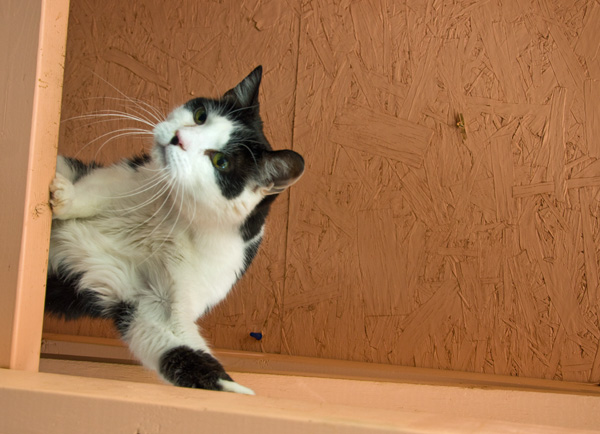
More than 700 felines occupy “Cat World;” a free-roaming indoor environment with screened porches for sunbathing and rafters for climbing.
These “Vicktory Dogs,” as they’re now known, were once seen by society and even by other animal rights groups like PETA, as too dangerous to let live. Ironically, after being rescued from Vick’s fighting ring they faced certain death at the hands of their rescuers who thought them incapable, or unworthy, of rehabilitation. But under the care of Best Friends, nine of these “lost causes” have already either been placed in new homes or are in the process of adoption. Seven more recently graduated to a status that makes them eligible to follow suit.
Turning Animals into Pets
Success like this doesn’t come easily, even for animals that never experienced the level of trauma endured by Vick’s pit bulls. For many the transition from shelter animal to beloved pet can be a difficult one, so great effort is made to prepare each animal for their eventual permanent home. Special facilities at the shelter are equipped with the kinds of surfaces and experiences pets are likely to encounter in houses, everything from linoleum floors to vacuum cleaners. Best Friends even has programs allowing volunteers to take the animals into town or home overnight so they are introduced to things that can’t be easily replicated at the shelter, like busy sidewalks and car rides.
These efforts pay impressive dividends. Whereas the normal return rate for adopted puppies can be as high as one in five, just two out of every one hundred animals adopted from Best Friends are returned. And in those rare instances where an adoption doesn’t work out, Best Friends stands ready to receive the pet – forever. Any animal taken in by Best Friends has a place to return to if needed for the rest of its life.
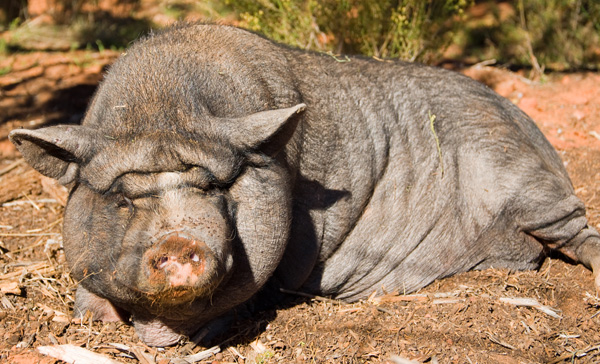
Potbellied pigs can make terrific pets but often lose their homes because of laws that treat them as farm animals.
That kind of lifetime commitment, not to mention the extensive care and attention provided to each animal, requires resources, lots of resources. In 2011 Best Friends spent more than $19 million on its animal care activities, about 91% of which came from individual donations and planned gifts. Not included in that budget is the value of work done by the roughly 7,000 visitors who volunteer at the shelter each year.
Better to Give Than to Receive
One of the ways Best Friends attracts this legion of workers is by making volunteering easy. Whether you have a single afternoon to offer or several months your contribution is always welcomed. Available tasks range from the completely unskilled, like feeding and cleaning, to construction and landscaping. A dedicated Volunteer Department (volunteers@bestfriends.org) allocates and organizes the thousands of helping hands toward their most productive use.
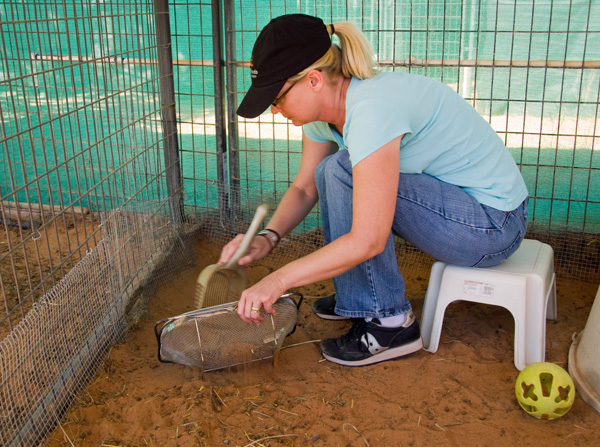
Volunteers, like Shannon here, get to see firsthand how their efforts make life just a little bit better.
An added draw is that many of the volunteering opportunities are simply enjoyable. Socializing animals is an important part of their rehabilitation, so many volunteers spend their time walking and playing with pets. During our visit we asked to be placed where the need was greatest and found ourselves in Wild Friends Rescue Village, an area set aside to house hundreds of rabbits rescued from a hoarding situation.
The residents of Wild Friends will never leave. Because of previous neglect many are sick and even paralyzed. Most have injuries from fighting amongst themselves. Nearly all are frightened of humans and are ill-suited to be pets. But at Best Friends they’ll at least live out their remaining days in relative comfort with care and companionship. And like the rest of the animals here who once needed help when the chips were down, they found the most remarkable thing imaginable: a Best Friend for life.










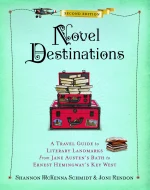



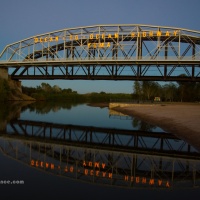




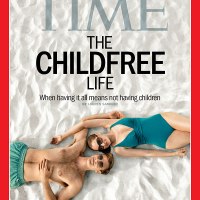

Definitely a must visit on our way to Alaska next summer. Thanks for sharing this remarkable place, as well as all the places you have visited. It’s inspiring.
LikeLike
You’ll definitely want to hit Southern Utah for all the great national parks. If you do, Kanab and Best Friends is right in the neighborhood.
LikeLike
Those stats are rather sickening. There are many countries where no-kill is the norm, or in fact the only legal way for a shelter to work. Wild Friends sounds like one of the best. Their adopt out record is impressive. Congratulations to them and thanks for sharing.
LikeLike
I didn’t know that many countries have “no-kill” shelter laws. One of the reasons shelters have such high kill rates here is because they must take in animals due to their animal control responsibilities. Eventually the animals outnumber the resources available to care for them. How do these “no-kill” countries afford to keep so many animals?
LikeLike
I wrote about these guys on What Gives 365 … what a great organization!!!
LikeLike
We should have known you had covered it first. LOL
LikeLike
Beautiful sentiments, about a sanctuary I was unaware of until now. I’ll be checking out their website just now.
LikeLike
I Love this place. Have been there about a dozen times to volunteer. You write up on them is great !!
LikeLike
I love what Best Friends does and often wish I lived closer so that I could volunteer. I do send money and think that this was a great post. Love our fur babies!
LikeLike
Such an amazing organization. It’s horrifying how many animals are killed every year. I hope more orgs like Best Friends Animal Society are able to succeed.
LikeLike
What a great place. I hope they can inspire others to do the same.
LikeLike
HI what a lovely blog you have. I hope you like Awards as there is one waiting for you on my Blog for being ” A Very Inspiring Blogger” Cheers Lorelle
LikeLike
Would love to visit, I really wasn’t aware of the amount of animals being killed in shelters!!!!!!!! It’s great to know that Best Friends are doing something about it, well done to everyone there what they are doing is amazing!!!!!! If they ever open a sanctuary in Britain I will definitely go and volunteer. Great Post 🙂
LikeLike
To be clear, the statistics in the article are estimates for what happens in the U.S. The situation in Britain may be different.
LikeLike
Living things, whether pets, children, or gardens require space, time, energy, and finances to care for properly. Too many of us have become use to our throw away society, without realizing what we are tossing out: community. I’d be curious to see if their model of rescue, care, rehabilitation, adopting out or keeping in, would translate to less open spaces.
Oscar
LikeLike
Hi Oscar,
I agree with your thoughts on our “throw away society.” As to your question, I think Best Friend’s would say that if they were 100% successful in implementing their mission they’d be able to close the sanctuary doors for good. The need for such places is mostly driven by a huge surplus of animals. That surplus is mostly driven by deliberate over breeding and inadequate spaying and neutering. About half of BFs annual budget goes toward trying to correct those things.
So to answer your question more directly, the ultimate solution isn’t to build more places like Best Friend’s Animal Sanctuary, but to reduce and eventually eliminate the need for them – and thus the space they require.
LikeLike
Real debate in “the country” here about spay/neutering because of so many excess dogs/cats. Country folk don’t do that, but then they have 8 – 10 dogs around their place (same applies to human breeding here…)
LikeLike
That high number won’t be healthy animals? If so it is a tragedy. Animals are not commodities.
LikeLike
It includes healthy animals too. Space, and more specifically money, are the primary things that determine a shelter animal’s fate. In fact, I just learned that California is trying to shorten the length of time a shelter must keep an animal before killing it down to just 72 hours. The change is designed to save money.
LikeLike
This rattles my cage. We have Oscars Law over here which they are trying to get through Parliament. Stop Puppy Factories these poor dogs that are kept in cages and sometimes penned down to breed, bred so much that their uterus’s falls out with no human contact. RESPONSIBILITY people – everywhere – for too long it has fallen on deaf ears. SPAY or NEUTER your pet. DON’T buy a pet for Christmas – we have pet stores now not selling 2 weeks before Christmas to stop the ‘spontaneous purchase’.
Ban Pit Bull fighting and all other forms. Care for them – Pet Owners should be registered, have a licence. If you offend – you can’t own another animal. I am grateful that you have stricter laws over there then we have, I wish and hope that ours improve.
Sorry for the rant but I am a huge dog lover and it sickens me what supposed ‘human beings’ can inflict on an animal. Merry Christmas to all.
LikeLike
The stats astounded me. I am saddened by this. Animals are our family.
It is wonderful to know that there are remarkable beings whom commit to a no kill sanctuary. I am definitely checking out their website and am very glad I found your blog via Eunice!
LikeLike
Importunately all those stats are a sad truth……… Thank God there are people who are trying yo make a change……
LikeLike
Being a big dog person, it’s heart breaking to think about all of the animals that don’t get a chance. I’m glad there are places like Best Friends trying to change the norm.
LikeLike
Thanks for sharing this. I am definitely in the camp of adopting an animal rather than getting one from a breeder. There are so many pets that are ready and available to become part of one’s family, that I don’t understand why so many continue to demand to get one from a breeder. Thanks for visiting my blog!
LikeLike